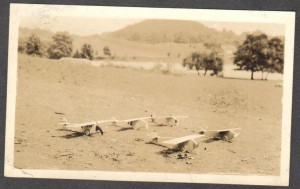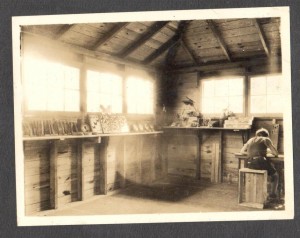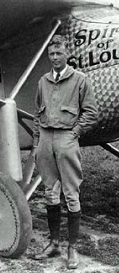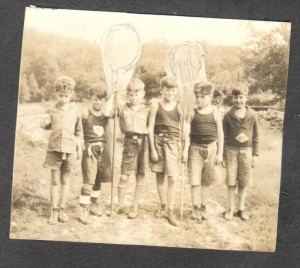My Father, Young J. D. Salinger, and “The Laughing Man”
The following letter from me to one of my school friends helps tell my Father’s story.
Hello Swede –
It’s been more than a year since I saw yet another instance of the reflected glow that shines for only a moment upon someone on the periphery of the periphery of a celebrated individual. I once wrote up this phenomenon as a skit for an unsuccessful TV show I worked on. In it, Nixon’s Japanese gardener finds a moment of fame on late night TV because of what he found in the pachysandra at San Clemente.
Awhile ago, the late E. Michael Mitchell had his moment. Mitchell the illustrator who created the carousel horse book jacket for, “The Catcher in the Rye,” had correspondence from Salinger that ended up in the Morgan Library & Museum. More recently, Mitchell’s Girlfriend found several more letters. They also have found their way to the Morgan Library.

My father was a bit of a recluse, like Salinger, himself. I’d like to think that I have saved him from exposure to minor celebrity, however brief or even posthumous, by keeping the fact secret that he knew not only Salinger but also the real live guy who provided the basis for the “Coach” character in, “The Laughing Man.”
Actually I learned the first part of this tale years ago, while you and I were still grinding at New Hampton. During a holiday break I stuffed, “Nine Stories,” in my father’s Christmas stocking. My intent was to impress upon him my yearning, while away prepping in New Hampshire, to return to New York. Today, looking back, I wouldn’t have made the connection myself. You will also remember back then, in Joe Rice’s overheated winter classroom, my literary sensibilities were not well developed.
Sometime, after I returned to school for the new semester, I got a response from my father to my usual requests for cash or LP records, or something else. However, this letter ended on an unusually long personal note. It was something like: “… finished your Salinger book. …don’t know about those other stories, but in one of them he’s writing from his own life and what he knew. I know because I now realize I knew Salinger back then when he was a young lad at Camp Lincoln and I worked for the fellow who ran the camp and possibly made up the tale of “The Laughing Man.” His name was, “Smutny,” and I always though that his name had a Dickensian ring to it.”
So Swede, here’s the gist of the story he told me:
“In the late 1920’s, while I was still a student at Columbia, each June I went upstate to work at Camp Lincoln, where young boys were sent to get them out of New York City and their parents’ hair for the summer months.
Smutny ran the camp and directed the athletics, and I took the boys on bird walks and helped them in their butterfly collecting. His wife was the nurse. All the boys tried to find excuses to go over to her office. It was not only homesickness for a mothering person. They loved her. I had a crush on her myself. On rainy days I would go to her office where she had a wind-up Victrola and recordings of some shopworn classics while the boys would build model airplanes in the Hobby bungalow. Airplanes of balsa and tissue paper were, “the cat’s pajamas.” Remember that Lindbergh’s wonderful flight was still big news.
“Then in the off-season Smutny took many of the same boys to Central Park each afternoon after school for sports and other activities. However, as the days grew shorter and the shadows longer, by late afternoon it became too dark to see the football and something had to be found to do until it was time to return the boys to their parents. So, Smutny had them return to the bus he drove and, in a winter version of campfire activities they would sing songs and tell stories until it was time to go home.
“I don’t know whether Salinger got the Laughing Man stories from Smutny, but that’s where he got the premise for his story, “The Laughing Man.” (signed) Your Father, RCR.” Curiously, he always signed his letters to me, “RCR,” as if he were initialing a memo to staff.
Years later my father was dealing with his terminal throat cancer and I went to stay with him at his place in New Jersey. He had begun to inventory his memories – for me he said, but also most likely for himself. This one cocktail hour, at the end of the day, at the end of the Summer, he sat sipping his bourbon as he went through tattered albums of photos he’d been taking for most of his life. I put down my glass of burgundy as he silently handed me a small photo – no more than a Box Brownie snapshot, really. In the picture were a handful of kids in camp gear (short sleeve shirts and shorts.) They were gathered before the camera and were all proudly proffering their individual collections of butterflies, mounted for display in the usual cigar boxes that little boys (even myself) had always used. As I looked at the pride and happiness written on their faces, my father pointed to one little face – “Salinger,” he rasped. And there he was.
Young Jerome David with an expression open and trusting before events in his life put wariness and caution into his countenance.
My father was so pleased to find this evidence of a younger self and a happier time that he insisted that we mount an expedition to Putnam County to seek out what might have become of Camp Lincoln to which he’d not returned in more than half a century.
Abandoned, overgrown and weedy, with a muddy little pond and tumbled down bungalows, Camp Lincoln had reverted to nature. “It’s not as big as the way I remember it,” my father managed to croak through his cancerous larynx. His memory took in this reality and we returned to the car.
Before the year’s end he was dead. I had arranged for him to go off to medical school from whence he eventually graduated. I had planned to scatter his remains to wind or wave. I briefly considered the ruins of Camp Lincoln as a possible disposal site before thinking better of it.
I was planning to put my small sailboat back into the water and so I set about disposing of the possessions of his lifetime. When, once again, I came upon the tattered albums with the sepia images and photos of the happy butterfly “Catchers,” I thought to myself, “What the Hell,” and sent one snapshot off to Salinger in New Hampshire with a brief explanation of its provenance.
Of course, true to form, Salinger never replied.
Take care of yourself.




